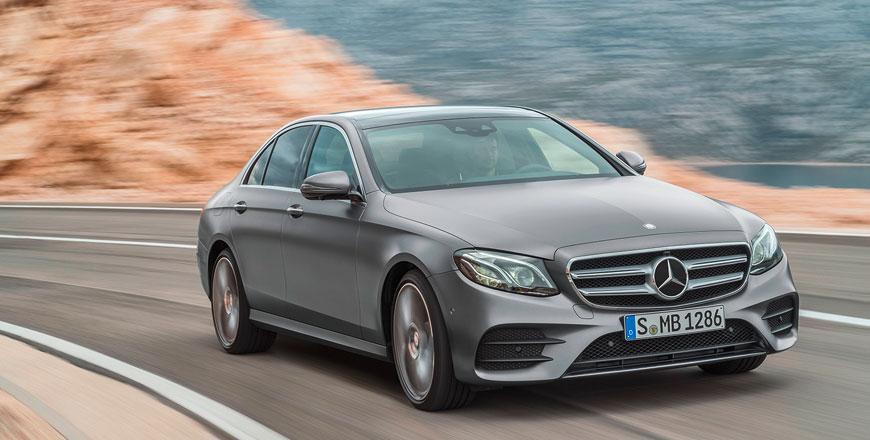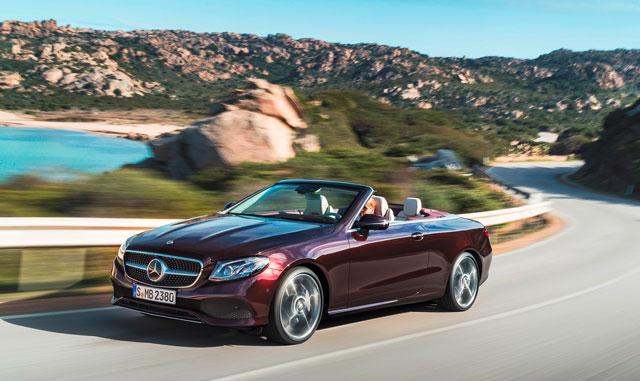You are here
Mercedes-Benz E200: Enhanced, elegant and now electrified executive
By Ghaith Madadha - Jan 18,2021 - Last updated at Jan 18,2021

Photos courtesy of Mercedes-Benz
One of Mercedes-Benz’s brand defining cars in an ever expanding and diversifying product portfolio, the E-Class executive saloon sums up the German automaker’s core appeal as luxurious but unostentatious, and as a status symbol that is at the same time sensible, practical and grounded. Undoubtedly among the brand’s most important cars, the current generation E-Class has hit the mark on the head in its current generation circa 2016.
For its customary mid-life refresh, the 2020 E-Class, however, gets an aesthetic revision, expanded drive-train electrification, updated driver assistance technology and enhanced interior comfort.
Dramatic re-design
A curvier and more flowing design than its chunkier predecessor when first launched in 2016, the W213 series E-Class was designed to better blend with its larger S-Class and small C-Class sister saloon lines’ design cues. It was elegant, fluent and smoothly styled, with a snouty grille with pronounced frame and bonnet surfacing, a flowing ridge along its flank, an arcing roofline and tapered boot. Revised — rather than replaced — for 2020, the E-Class is again brought up to speed in terms of a changing, more conservative, design direction at Mercedes-Benz.
Most obviously different at the rear, the revised E-Class trades the outgoing version’s vertically-oriented diamond-like rear lights for moodier slim, prominently browed and horizontally-oriented lights, along with slight bootlid and bumper changes. At the front, the grille, lights and bumper are re-oriented for a new grille outline that is wider at the bottom, rather than the top, for a more dramatic, if formal, look. Driven with AMG Line exterior styling option, the new E-Class also features a new floating emblem, flanked by single — instead of double — slats and a rhinestone-like background grille pattern.
Perkier performance
Adopting a more aggressive dual ridge surface treatment, the revised E-Class’ bonnet hides a significantly revised 2-litre turbocharged direct injection 4-cylinder engine in E200 guise, as driven. Positioned longitudinally and driving the rear wheels through a smooth-shifting 9-speed automatic gearbox, the new E200’s combustion engine is a mild hybrid design incorporating a 48-Volt starter/generator system that recuperates kinetic braking energy. Powering some ancillary systems and allowing for longer coasting and stop/start system functionality to reduce fuel consumption, the 48V system also develops up to 13BHP and 118lb/ft torque to pitch in with driving duties.
Meaningfully more powerful than the model it directly replaces, the new E200 meanwhile might not serve up quite the same muscle as the full hybrid E350, but does feature a better integrated hybrid system and more seamless power delivery. The new E200 also delivers better performance consistency over a long distance and over demanding, electric charge-sapping terrain, topography and driving style than the nominally quicker E350. That all said, the new E200’s combustion engine is a clear improvement, developing 194BHP throughout a broad 5,500-6,100rpm range and 236lb/ft torque across a broad 1,650-4,000rpm band.
Confident control
With its new systems gaining back some of the weight the E-Class lost due to increased aluminium content back in 2016, the refreshed 2020 E200’s improved output nevertheless delivers quicker 0-100km/h acceleration, down from 7.7- to now 7.4-seconds, while top speed remains the same at 240km/h despite marginally improved aerodynamic efficiency. Confident and as quick as reasonably needed for most circumstances, the E200 is responsive from idling with little by way of turbo lag, and is willing to redline. It is, however, characterised by its broad, easily accessible and versatile mid-range sweet spot.
Expectedly stable and reassuringly planted at speed, the E200’s multi-link suspension delivers a smooth, refined and comfortable ride, with adaptive dampers doing much to off-set its optional low profile 245/40R19 front and 275/35R19 rear tyres’ firmness. Tightening dampers for tauter body control through corners, the E200’s Agility Control system meanwhile loosens damper rates for a more forgiving ride over imperfect textures. For the most part this job is accomplished very well, but for local roads’ more punishing ruts, lumps and bumps, a less sporty higher profile tyre option would offer yet more comfort.
Classy comfort
Buttoned down on rebound and settled in its ride, the E200 may be primarily concerned with refinement, reassurance and comfort, but it nevertheless avails itself well dynamically. Eager and tidy into corners with its direct and precise — if clinical — steering, taut front grip and balanced weighting the E200 well controls weight shifts and grips very well when leaning into a long corner. Happy to change directions with poise and confidence, the E200’s rear can, however, be edged out under if provoked with sudden power surges, as electronic stability controls subtly supplement mechanical grip.
Comfortable inside with good driving position, adjustability, luggage volume and front and rear passenger space, the elegantly upmarket E-Class is mildly updated inside for a subtly sportier, more refined feel with classy materials and design. Equipped with extensive standard and optional updated driver assistance, convenience, comfort and connectivity, including intuitive infotainment and instrumentation dual screens, the driven car featured Active Brake Assist and Blind Spot Assist, the latter, which proved very useful. Also useful were its parking cameras and sensors, which along with a tight turning circle, make parking and manoeuvring easy.
TECHNICAL SPECIFICATIONS
- Engine: 2-litre, turbocharged, in-line 4-cylinders
- Electric motor: 48V starter/generator
- Bore x stroke: 83 x 92mm
- Compression ratio: 9.8:1
- Valve-train: 16-valve, DOHC, variable timing, direct injection
- Gearbox: 9-speed automatic, rear-wheel-drive
- Power, BHP (PS) [kW]: 194 (197) [145] @5,500-6,100rpm
- Specific power: 97.6BHP/litre
- Power-to-weight: 114.3BHP/tonne
- Electric motor, power, BHP (PS) [kW]: 13 (14) [10]
- Torque, lb/ft (Nm): 236 (320) @1,650-4,000rpm
- Specific torque: 160.7Nm/litre
- Torque-to-weight: 188.2Nm/tonne
- Electric motor, torque, lb/ft (Nm): 118 (160)
- 0-100km/h: 7.4-seconds
- Top speed: 240km/h
- Fuel economy, combined: 6.5-6.9-litres/100km
- CO2 emissions, combined: 149-158g/km
- Fuel capacity: 60-litres
- Length: 4,935mm
- Width: 1,852mm
- Height: 1,460mm
- Wheelbase: 2,939mm
- Track, F/R: 1,604/1,608mm
- Overhang, F/R: 853/1,143mm
- Headroom, F/R: 1,052/971mm
- Shoulder room, F/R: 1,468/1,450mm
- Aerodynamic drag co-efficient: 0.25
- Boot capacity: 540-litres
- Unladen weight: 1,700kg
- Suspension: Multi-link
- Steering: Electric-assisted rack & pinion
- Turning circle: 11.6-metres
- Brakes: Ventilated discs
- Tyres, F/R: 245/40R19/275/35R19 (optional)
Related Articles
Perhaps the most defining model among Mercedes-Benz’ various model lines across the years, the E-Class sums up the brand’s luxurious yet uno
Sitting right in the middle of a broad range of two-seat roadster and four-seat boulevardier convertibles offered across the Mercedes-Benz r
Refreshed to more closely integrate with the German manufacturer’s revised design language as exemplified by new S- and C-Class models, Merc


















